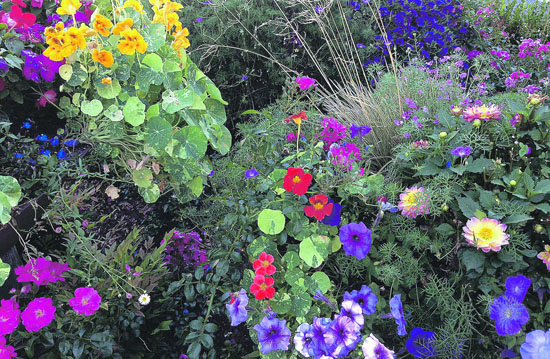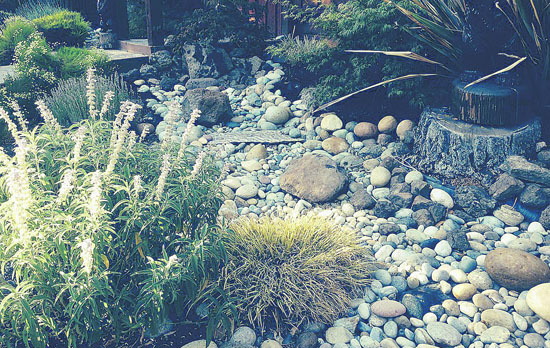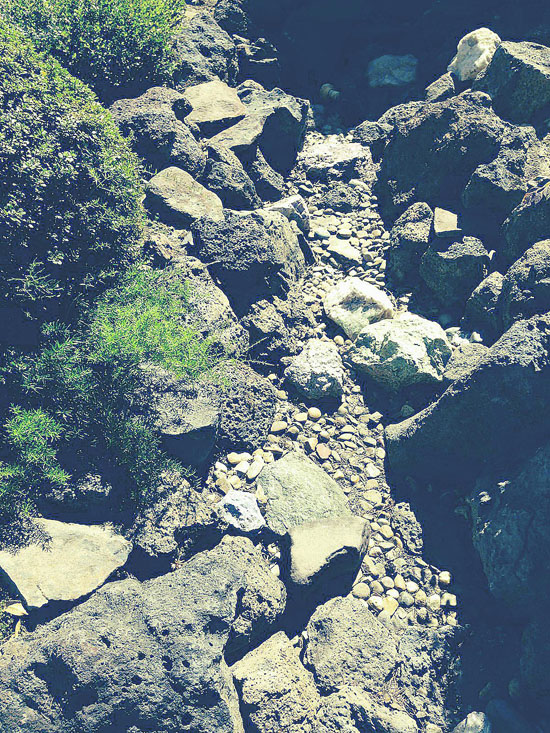|
|
Published August 13th, 2014
|
Digging Deep-Gardening with Cynthia Brian
Romancing the Stone
|
|
| By Cynthia Brian |
 |
| If you want color around your river, nasturtium, dahlia, petunia, and baby roses brighten the landscape. |
"When all the water has gone, only the largest stones will still remain in the riverbed." -African proverb
 Fifty-eight percent of California is now experiencing exceptional drought conditions considered by experts to be worse than the droughts of 1924 and 1977. If we have learned anything from our state history, it is that water is a precious commodity. There is not enough water to subsidize our landscapes and many people are wondering how we can win the fight to minimize our usage of H2O and still have an attractive garden. One solution is to romance the stone.
Fifty-eight percent of California is now experiencing exceptional drought conditions considered by experts to be worse than the droughts of 1924 and 1977. If we have learned anything from our state history, it is that water is a precious commodity. There is not enough water to subsidize our landscapes and many people are wondering how we can win the fight to minimize our usage of H2O and still have an attractive garden. One solution is to romance the stone.
 I'm not talking about replacing your landscaping with the tacky white gravel of the '70s, but instead installing an arroyo seco or dry creek which works not only as an alternative to a water feature, but becomes a useable water way when winter rains finally fall. Also called a rain garden, a dry brook will absorb and filter storm water preventing flooding, contamination, and soil erosion in winter while looking beautiful in the dry summer months.
I'm not talking about replacing your landscaping with the tacky white gravel of the '70s, but instead installing an arroyo seco or dry creek which works not only as an alternative to a water feature, but becomes a useable water way when winter rains finally fall. Also called a rain garden, a dry brook will absorb and filter storm water preventing flooding, contamination, and soil erosion in winter while looking beautiful in the dry summer months.
 Building a Dry Creek or Arroyo Seco
Building a Dry Creek or Arroyo Seco
 To be effective, a completed arroyo seco needs to mimic a small flowing river so that it is not only esthetically pleasing but can structurally channel run off water to an area where you need it. The finished goal is to have it look as natural as possible. In nature, streams twist, turn, and curve, formed by a mixture of large river rocks, big boulders, smaller pebbles, driftwood, and plants.
To be effective, a completed arroyo seco needs to mimic a small flowing river so that it is not only esthetically pleasing but can structurally channel run off water to an area where you need it. The finished goal is to have it look as natural as possible. In nature, streams twist, turn, and curve, formed by a mixture of large river rocks, big boulders, smaller pebbles, driftwood, and plants.
 Before you begin, ask yourself a few questions:
Before you begin, ask yourself a few questions:
 Why do you want an arroyo seco?
Why do you want an arroyo seco?
 What are your expectations for the results?
What are your expectations for the results?
 Where is the optimum location?
Where is the optimum location?
 How long and how wide will it be?
How long and how wide will it be?
 Will it work with the overall style of your home and current landscaping?
Will it work with the overall style of your home and current landscaping?
 Will it have to be engineered or is this a DIY project?
Will it have to be engineered or is this a DIY project?
 How much can you budget?
How much can you budget?
 Steps for DIY
Steps for DIY
 Building a dry creek is remarkably simple. You may need some help with labor and lifting, but the rest is a pleasurable do-it-yourself project.
Building a dry creek is remarkably simple. You may need some help with labor and lifting, but the rest is a pleasurable do-it-yourself project.
 1. Observe natural creeks or streams. Take lots of photos. You'll notice that they don't follow any pattern, but meander.
1. Observe natural creeks or streams. Take lots of photos. You'll notice that they don't follow any pattern, but meander.
 2. Begin and end in an area that could realistically be a creek bed.
2. Begin and end in an area that could realistically be a creek bed.
 3. Determine the size, making sure to make some areas are wider and that the flow is sloping downhill.
3. Determine the size, making sure to make some areas are wider and that the flow is sloping downhill.
 4. Remove any lawn and other vegetation. (Check with EBMUD if you are removing grass as you may qualify for a rebate by replacing your lawn with the new dry creek.)
4. Remove any lawn and other vegetation. (Check with EBMUD if you are removing grass as you may qualify for a rebate by replacing your lawn with the new dry creek.)
 5. Mark your design with landscape paint, flour, or spray paint.
5. Mark your design with landscape paint, flour, or spray paint.
 6. Dig the creek bed twice as deep as it is wide. It's easiest to shovel the dirt from the middle to build up the sides of the banks.
6. Dig the creek bed twice as deep as it is wide. It's easiest to shovel the dirt from the middle to build up the sides of the banks.
 7. Tap the soil down firmly several times until it is solid.
7. Tap the soil down firmly several times until it is solid.
 8. Line the channel and sides with landscape cloth. You can purchase landscape cloth in rolls that are 4 feet by 50 feet for about $30 at hardware and garden centers. Attach the cloth to the dirt with inexpensive landscape pins, which cost about $6 a bag.
8. Line the channel and sides with landscape cloth. You can purchase landscape cloth in rolls that are 4 feet by 50 feet for about $30 at hardware and garden centers. Attach the cloth to the dirt with inexpensive landscape pins, which cost about $6 a bag.
 9. Cover the cloth with pea gravel and/or sand. I use sand as a base, then gravel on top as it doesn't wash away easily.
9. Cover the cloth with pea gravel and/or sand. I use sand as a base, then gravel on top as it doesn't wash away easily.
 10. Visit a local quarry, masonry supplier, or landscape center that carries rocks and boulders to choose the various sizes to add to your creek. You will need to walk around and decide on the color and types of rocks you want. Again, think natural looking.
10. Visit a local quarry, masonry supplier, or landscape center that carries rocks and boulders to choose the various sizes to add to your creek. You will need to walk around and decide on the color and types of rocks you want. Again, think natural looking.
 11. Order gravel, sand, rounded river rocks, lava rocks, and boulders for delivery. There is normally a delivery charge, but check around.
11. Order gravel, sand, rounded river rocks, lava rocks, and boulders for delivery. There is normally a delivery charge, but check around.
 12. Fill the channel and sides with the various sizes of rounded river rocks. Add a few boulders randomly throughout.
12. Fill the channel and sides with the various sizes of rounded river rocks. Add a few boulders randomly throughout.
 13. Finish the installation with the creek ending in a spillway of gravel and rocks that segue to your landscape naturally or if you have a pond, end your creek here.
13. Finish the installation with the creek ending in a spillway of gravel and rocks that segue to your landscape naturally or if you have a pond, end your creek here.
 14. Tuck reeds, grasses, bulbs, and flowers into crevices on the topsides and add whatever other plants fit your design and color desires.
14. Tuck reeds, grasses, bulbs, and flowers into crevices on the topsides and add whatever other plants fit your design and color desires.
 15. If appropriate, add a flagstone bridge, or large stepping stones to walk across the stream.
15. If appropriate, add a flagstone bridge, or large stepping stones to walk across the stream.
 16. Solar lights are a terrific enhancement for nightscaping.
16. Solar lights are a terrific enhancement for nightscaping.
 Plants
Plants
 The plants you choose will depend on your sun and shade exposure, water needs, size of your creek, location, and landscape design. You can make your dry creek elegant, woodsy, wild, or a combination. Slip a fern between the rocks and allow for cascading blossoms from lobelia or lantana to soften the system. Choose specimens of interest from this minimal selection.
The plants you choose will depend on your sun and shade exposure, water needs, size of your creek, location, and landscape design. You can make your dry creek elegant, woodsy, wild, or a combination. Slip a fern between the rocks and allow for cascading blossoms from lobelia or lantana to soften the system. Choose specimens of interest from this minimal selection.
 Ornamental grasses
Ornamental grasses
 Succulents
Succulents
 Iris
Iris
 Wild Strawberry
Wild Strawberry
 Ferns
Ferns
 Hosta
Hosta
 Astilbe
Astilbe
 Lantana
Lantana
 Lavender
Lavender
 Nasturtium
Nasturtium
 Baby roses
Baby roses
 Daylilies
Daylilies
 Sedum
Sedum
 Society Garlic
Society Garlic
 Trailing Rosemary
Trailing Rosemary
 Shasta Daisy
Shasta Daisy
 Pussy Willow
Pussy Willow
 Crocus
Crocus
 Cat Tails
Cat Tails
 Mexican Bush Sage
Mexican Bush Sage
 Calla Lilies
Calla Lilies
 Canna
Canna
 Dahlias
Dahlias
 Horsetail
Horsetail
 Corabells
Corabells
 Bleeding Heart
Bleeding Heart
 Lamb's Ear
Lamb's Ear
 Sago Palm
Sago Palm
 Peony
Peony
 Natives
Natives
 Annuals (petunias, zinnia, cosmos, etc)
Annuals (petunias, zinnia, cosmos, etc)
 Trees that complement a dry creek may include willow, Japanese maple, Birch, and Weeping Cherry.
Trees that complement a dry creek may include willow, Japanese maple, Birch, and Weeping Cherry.
 By improving our water conservation, water use efficiency, and getting creative with our water recycling, landscaping, and runoff prevention techniques, we will be able to weather the storm. Installing an arroyo seco addresses many of these sustainable strategies while beautifying our environment.
By improving our water conservation, water use efficiency, and getting creative with our water recycling, landscaping, and runoff prevention techniques, we will be able to weather the storm. Installing an arroyo seco addresses many of these sustainable strategies while beautifying our environment.
 Happy Gardening! Happy Growing!
Happy Gardening! Happy Growing!

|
 |
| A dry creek planted with sage, lavender, and New Zealand Flax. |
 |
| Lava rocks anchor this arroyo seco while river rocks, pebbles, and quartz add interest. |
 |
| Cynthia Brian |
|
|
 (c)2014 Cynthia Brian (c)2014 Cynthia Brian
 The Goddess Gardener The Goddess Gardener
 StarStyle(r) Productions, llc StarStyle(r) Productions, llc
 Cynthia@GoddessGardener.com Cynthia@GoddessGardener.com
 www.GoddessGardener.com www.GoddessGardener.com
 I am available as a speaker, designer, and consultant. I am available as a speaker, designer, and consultant. |
|
|
|
|













